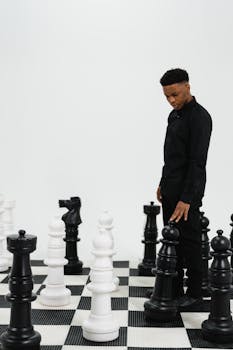Pulling off a brilliant move in a strategy game feels a lot like finding a shortcut when traffic has everyone stuck. You outwit the system, and victory feels earned. Mobile strategy games turn this thrill into an everyday hobby that keeps your mind alert.
Thinking several moves ahead isn’t just for chess masters anymore. The best strategy games on mobile blend classic tactics with digital twists, giving players a chance to test not just their memory but their ability to adapt and solve new challenges in real time.
From navigating alliances in virtual worlds to deciding how to use limited resources effectively, these games stretch your imagination. Dive into this guide to spot titles designed to improve focus, planning, and critical thinking while offering hours of satisfying gameplay.
Building Tactical Skills One Turn at a Time
Each strategy mobile game forms a digital playground where you practice analyzing options, learning patterns, and predicting outcomes. These skills translate to real-life problem-solving and are accessible through carefully crafted gameplay systems.
Take, for example, games that split your choices between offense and defense. Deciding when to risk your resources or keep your guard up mirrors choices you might make in daily tasks or negotiations.
Structuring Thought: A Step-by-Step Example
Consider a game where you’re up against an unpredictable opponent. You spot a weakness in their formation, pause, and plan a multi-step attack to exploit their lapse.
You quickly check your resources: are you able to commit while still leaving something in reserve? With one decisive move, you act, then adapt to their counterattack. That’s critical thinking in practice.
Main takeaway: Each move is supported by observation, resource tracking, and anticipation. Playing this way embeds agile thinking and flexible planning — useful habits in any field.
Mini Checklist: Deciding on Your Next Move
After analyzing a battle map, run through a checklist: Assess resources. Isolate weakest points. Weigh possible responses. Imagine your opponent’s next move. Then, execute the smartest option, confident you’ve covered the essentials.
If you rush in, observe what happens and adjust next turn. The feedback loop encourages improvement and helps you form strategies that go beyond a single victory.
As you practice, you learn to create checklists in real life: shopping, work tasks, or planning a trip. Each list improves efficiency and reduces mistakes.
| Game | Main Focus | Critical Skill | Suggested Action |
|---|---|---|---|
| Turn-based Tactics | Precise Planning | Anticipation | Preview all moves before committing |
| Real-Time War | Resource Balance | Adaptability | Adjust plans when surprised |
| Puzzle Defense | Spatial Insight | Pattern Recognition | Match new shapes with defenses |
| Economic Sim | Long-term Growth | Trade-offs | Delay gratification for larger rewards |
| Social Alliances | Negotiation | Empathy | Listen before making a deal |
Comparing Approaches: Slow Planning Versus Fast Reaction
Some strategy games give you all the time you need to plan, while others force split-second choices. Both develop related, but distinct, mental skills that pay dividends outside of gaming.
Turn-based titles reward steady deliberation, letting players consider every angle and double-check their logic. By contrast, real-time games push for on-the-fly adjustments, demanding quick prioritization and mental flexibility.
Integrating Both Modes in Everyday Tasks
Imagine you’re scheduling your week. The turn-based approach is like mapping events and deadlines calmly, adjusting until everything lines up. Real-time tactics come into play when a last-minute request pops up, and you have to shuffle your whole plan on the spot.
Recognizing which mode to use, and when, is key in both gaming and life. Try mentally labeling moments as “turn-based” (plan ahead) or “real-time” (react) this week for clearer decision-making.
- Set a five-minute timer to practice fast, real-time micro-decisions in games.
- Use a pen-and-paper map to plan a complex scenario, mirroring turn-based strategies.
- Switch roles between fast and slow play with a friend, noticing which feels most natural.
- Build in pauses for review after quick actions; self-feedback loops encourage steady progress.
- Role-play multitasking under simulated pressure, using cues from real-time games to prioritize.
Testing both modes shows you strengths to build on, and gaps needing attention. Plan practice sessions intentionally, alternating slow and fast approaches for balanced growth.
Five More Ways to Practice Strategic Switching
Adopt a “commentary voice” during play to narrate your decision process. Maintain an action log after each round, briefly stating what worked and what didn’t.
Try pausing a game mid turn, writing down two alternative next steps, and acting out both in practice. Compare outcomes to strengthen your ability to forecast consequences.
- Keep an eye on subtle patterns forming in games, noting how your reactions differ over time.
- Pair up for “ping-pong” planning sessions, flipping between fast and slow strategic moves with each turn.
- Review your choices with a trusted friend who can point out patches of bias or haste.
- Deliberately swap roles: play defense one round, attack the next, tracking mindset shifts.
- Treat each defeat as a learning opportunity, checking what you’d do differently with more (or less) time.
Switching between planning and reacting in games is practice for real-world flexibility. Use simple logs or accountability partners to stay honest and deepen the benefits.
Reading Patterns and Spotting Hidden Opportunities
Winning strategy games consistently rests on seeing beyond the surface. The first scan may not reveal a hidden threat or a clever way around obstacles, but with careful pattern tracking, new solutions emerge.
Great players talk about “reading the board” as if it’s a kind of body language. It’s a practice you can sharpen with focused drills and curiosity.
Zeroing In on Subtle Cues
If a digital opponent repeats a move or delays upgrading a unit, your attention should shift immediately. Noticing trends can feel like catching a friend’s poker tell or a repeating typo in a document.
Spotting these micro-signals doesn’t require lightning speed. Focus on one area per game: maybe patterns emerge in how the AI reinforces defenses or launches sneak attacks, letting you counter more effectively.
After each session, jot down one surprising “tell” you noticed and how you exploited it. Over time, your pattern-reading skills will outpace the average player.
Thinking Several Steps Ahead
Picture a chess player planning three moves forward. Urban planners use similar thought processes, anticipating what will happen if a new road is built. Mobile strategy games encourage forecasting in manageable, stress-free chunks.
In each round, try sketching out your next three planned actions as a sequence. Review after playing: Did the scenario change? Was the forecast accurate? This habit speeds up learning and tightens strategy.
If a surprise throws your plan, treat it as a reset — build a new, adjusted sequence for the remainder of the game. Each disruption is a mini-lesson in flexibility.
Balancing Aggression and Patience Across Game Types
Choosing between bold attacks and cautious waiting is a challenge in both classic and innovative strategy titles. Some games punish impatience, while others reward calculated risks.
Analyzing a game’s risk-reward structure before acting can help you find your comfort zone. Let’s compare three common types based on their aggression and patience demands.
| Game Type | Best For Aggressors | Best For Planners |
|---|---|---|
| Real-Time Battles | Pushing for quick victories, capitalizing on hesitation | Careful unit rotation, efficient resource stockpiling |
| Base-Builders | Launching early raids, setting tempo | Steady upgrades, holding back for late-game strength |
| Puzzle Hybrids | Sneak attacks, rare dramatic swings | Slow, methodical buildup before a big finish |
If a game repeatedly penalizes haste, use it as a lab for patience. In a title that rewards surprises, test those bolder moves, and review which approach fits your instincts best.
The Shared Language of Strategy Games and Everyday Choices
Strategy games borrow from real life, giving you a laboratory to rehearse negotiations and split-second decisions. Battling for resources can mimic haggling for a good price or negotiating who picks up dinner.
Picture someone weighing the grocery list against the week’s meal plan. Similarly, effective players track resources, forecast shortages, and adjust on the fly. This process turns abstract mechanics into practical skills you’ll use outside gaming.
Analogies abound; think of your friend group as an alliance in a multiplayer game. Navigating shifting priorities, trust, and group resources teaches lessons you can use at work, school, or home.
For example, a player says, “If I build this tower now, my defenses are stronger, but I’ll have fewer upgrades next turn.” That’s a tradeoff you might face in budgeting or long-term projects, instantly relatable.
Mindset Shifts for Strategic Growth in Play and Life
- Embrace uncertainty: Try bold moves in games that mirror ambiguous decisions at work or home.
- Start review journals: After every win or loss, write down new patterns you noticed and what you’ll tweak next time.
- Discuss choices: Review your moves with others, listening for new perspectives and constructive criticism.
- Pace yourself: Intentionally alternate between risky and safe play styles, noting mindset shifts with each.
- Gamify learning: Treat feedback (even in real life) as clues for “leveling up” your own critical thinking.
- Design scenarios: Challenge yourself by inventing new goals and obstacles mid-game. Adapt, then repeat for growth.
Adopting these habits moves strategic thinking from the screen to daily life, preparing you for unpredictable situations and sharpening your ability to adapt under pressure.
Practicing review and discussion with peers turns gaming into a group learning activity — it’s about improving together, not just competing alone.
Reflecting on Progress: Staying Curious and Expanding Your Toolkit
Every session spent analyzing moves, balancing resources, or navigating alliances builds a toolkit of decision-making habits. The impact goes beyond individual games, teaching you to read situations and adapt in diverse scenarios.
Pairing in-game lessons with daily routines reveals new strengths. Where you once guessed, you now have systems in place: checklists, reviews, even adapting tactics midstream. These habits compound, building sharper intuition.
Strategy mobile games shine brightest when you approach them with curiosity. Treat every outcome, win or lose, as a fresh data point for your next improvement cycle. Growth comes from honest self-review.
The landscape of strategy games is vast, with new titles continually pushing boundaries. Keep experimenting, mix genres, and challenge yourself with fresh puzzles to avoid stagnation.
Ultimately, your critical thinking journey is ongoing. Use mobile games as training grounds, bringing each lesson back into everyday challenges and decisions. Embrace the learning curve and watch your strategic skills flourish.

